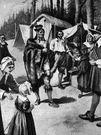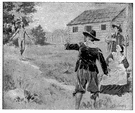|
|

The Wampanoag
Part 1: First Meetings
The Wampanoag were one of the Alonquin tribes that lived in what English settlers later called New England. These Native Americans were farmers by nature. They also fished and hunted for food.
 They lived in villages and had men in charge called sachems. The tribes also had a Great Sachem, who was a sort of leader of all the tribes. European settlers referrred to the Great Sachem as a king, but he wasn't a king as Europeans thought of kings. He was the tribes' leader, yes, but he was more of a spokesman and role model and not so much a powerful man who sat on a throne and imprisoned people who didn't do what he told them to do. (The sachem, also, could be a woman, provided that no male heir was available when a sachem died.) They lived in villages and had men in charge called sachems. The tribes also had a Great Sachem, who was a sort of leader of all the tribes. European settlers referrred to the Great Sachem as a king, but he wasn't a king as Europeans thought of kings. He was the tribes' leader, yes, but he was more of a spokesman and role model and not so much a powerful man who sat on a throne and imprisoned people who didn't do what he told them to do. (The sachem, also, could be a woman, provided that no male heir was available when a sachem died.)
During the 16th Century (the 1500s), European fishing boats began appearing more and more along the Atlantic coast. Most of these fishermen's encounters with the Wampanoag were friendly. This friendliness can be seen in their reaction to the landing and settlement actions of the Pilgrims in 1620.
An exception to these friendly meetings was a group of English sailors who made a living selling slaves to others in Europe. These sailors made a habit of sailing to America, capturing Native Americans, and bringing them back to Europe to sell as slaves to the highest bidder. One such victim of this deplorable practice was none other than Squanto, the Wampanoag who was so friendly to the Pilgrims.
 Squanto was a member of the Patuxet settlement. He was carried off as a slave by an English captain named Thomas Hunt in 1614. He served as a slave for Spanish monks for a few years and then escaped. By this time, he spoke English rather well and decided to go to England itself. He got a job as an interpreter on a ship that sailed back to America. Once there, he discovered that an illness brought over by Europeans had wiped out his entire village. Had he been there, he might very well have died as well. His family and friends all gone, Squanto went and lived with another Wampanoag tribe. Squanto was a member of the Patuxet settlement. He was carried off as a slave by an English captain named Thomas Hunt in 1614. He served as a slave for Spanish monks for a few years and then escaped. By this time, he spoke English rather well and decided to go to England itself. He got a job as an interpreter on a ship that sailed back to America. Once there, he discovered that an illness brought over by Europeans had wiped out his entire village. Had he been there, he might very well have died as well. His family and friends all gone, Squanto went and lived with another Wampanoag tribe.
It was at the very site of his tribe's former home that the Pilgrims finally landed in 1620 (after a few false starts because of bad weather).
 The Wampanoag knew that the Pilgrims had arrived but, suspicious of their motives, did not approach them for some time. The Pilgrims suffered through the brutal winter of 1620. Half of them died. Those who survived were startled to see Samoset, a sachem from the Abenaki tribe, walk into their settlement one day in March and say, "Hello, Englishmen" (in English). Samoset, it seemed, had spent some time with English at the Kennebic River colony a few years before. He had avoided the kind of illness that had killed Squanto's people, but he did manage to pick up a few words of English, which came in very handy when he and Squanto decided to make contact with these new English settlers. The Wampanoag knew that the Pilgrims had arrived but, suspicious of their motives, did not approach them for some time. The Pilgrims suffered through the brutal winter of 1620. Half of them died. Those who survived were startled to see Samoset, a sachem from the Abenaki tribe, walk into their settlement one day in March and say, "Hello, Englishmen" (in English). Samoset, it seemed, had spent some time with English at the Kennebic River colony a few years before. He had avoided the kind of illness that had killed Squanto's people, but he did manage to pick up a few words of English, which came in very handy when he and Squanto decided to make contact with these new English settlers.
Next
page > A New Alliance
> Page 1, 2, 3, 4
|
|



 They lived in villages and had men in charge called sachems. The tribes also had a Great Sachem, who was a sort of leader of all the tribes. European settlers referrred to the Great Sachem as a king, but he wasn't a king as Europeans thought of kings. He was the tribes' leader, yes, but he was more of a spokesman and role model and not so much a powerful man who sat on a throne and imprisoned people who didn't do what he told them to do. (The sachem, also, could be a woman, provided that no male heir was available when a sachem died.)
They lived in villages and had men in charge called sachems. The tribes also had a Great Sachem, who was a sort of leader of all the tribes. European settlers referrred to the Great Sachem as a king, but he wasn't a king as Europeans thought of kings. He was the tribes' leader, yes, but he was more of a spokesman and role model and not so much a powerful man who sat on a throne and imprisoned people who didn't do what he told them to do. (The sachem, also, could be a woman, provided that no male heir was available when a sachem died.) Squanto was a member of the Patuxet settlement. He was carried off as a slave by an English captain named Thomas Hunt in 1614. He served as a slave for Spanish monks for a few years and then escaped. By this time, he spoke English rather well and decided to go to England itself. He got a job as an interpreter on a ship that sailed back to America. Once there, he discovered that an illness brought over by Europeans had wiped out his entire village. Had he been there, he might very well have died as well. His family and friends all gone, Squanto went and lived with another Wampanoag tribe.
Squanto was a member of the Patuxet settlement. He was carried off as a slave by an English captain named Thomas Hunt in 1614. He served as a slave for Spanish monks for a few years and then escaped. By this time, he spoke English rather well and decided to go to England itself. He got a job as an interpreter on a ship that sailed back to America. Once there, he discovered that an illness brought over by Europeans had wiped out his entire village. Had he been there, he might very well have died as well. His family and friends all gone, Squanto went and lived with another Wampanoag tribe. The Wampanoag knew that the Pilgrims had arrived but, suspicious of their motives, did not approach them for some time. The Pilgrims suffered through the brutal winter of 1620. Half of them died. Those who survived were startled to see Samoset, a sachem from the Abenaki tribe, walk into their settlement one day in March and say, "Hello, Englishmen" (in English). Samoset, it seemed, had spent some time with English at the Kennebic River colony a few years before. He had avoided the kind of illness that had killed Squanto's people, but he did manage to pick up a few words of English, which came in very handy when he and Squanto decided to make contact with these new English settlers.
The Wampanoag knew that the Pilgrims had arrived but, suspicious of their motives, did not approach them for some time. The Pilgrims suffered through the brutal winter of 1620. Half of them died. Those who survived were startled to see Samoset, a sachem from the Abenaki tribe, walk into their settlement one day in March and say, "Hello, Englishmen" (in English). Samoset, it seemed, had spent some time with English at the Kennebic River colony a few years before. He had avoided the kind of illness that had killed Squanto's people, but he did manage to pick up a few words of English, which came in very handy when he and Squanto decided to make contact with these new English settlers.
